Road Trips by a Family of Four – Grandparents, Mom, Teenage Daughter
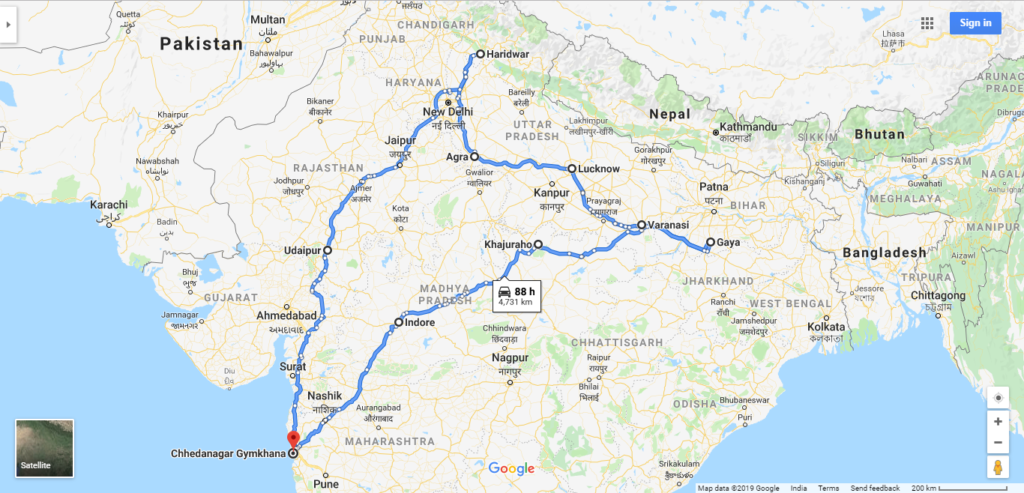
What came foremost to mind about this road trip was the very cold and foggy winter. Maybe it was because we set out at dawn, usually 4am to cover the long distances. On the days we were on the road, it seemed we were rushing past clouds with naught to be seen ahead or behind except the faint twinkling lights of other vehicles. It was cold in the car too, and we were all wrapped up in warm hoodies and shawls. Appa wore a scarf round his head and ears under his hoodie, though the temperature inside was raised. This was our long, 14-day road trip to the Great North in December 2019. We crossed 8 states and 1 UT in this 5200 km journey – Mumbai to Udaipur, Haridwar, Rishikesh, Agra, Lucknow, Ayodhya, Allahabad, Benaras, Sarnath, Bodh Gaya, Khajuraho, Indore and back to Mumbai. A mega-trip that was an endurance test for Amma and Appa. We were inspired by all we saw and experienced. We felt, as always, truly fortunate to have been able to see glimpses of this great land.

Beautiful, stylish, comfortable, ever dependable, secure, our home-away-from-home. Just getting into the car relaxed us. The familiar smells of wax and faint lime fragrance were always soothing. She was raring to go. Once on the open road she leaped with eagerness.
In the Mahabharata, Arjuna worships his chariot before setting out to the battlefield in the war with the Kauravas. He circumambulates it with folded hands. My daughter and I do the same before setting out on any road-trip. We circumambulate our Altis three times with folded hands and pray she takes care of herself and us throughout the long journey. And our earthly chariot has never let us down.
Thank you Toyota for our beloved car.
The GQ or Golden Quadrilateral is a network of highways connecting India’s four top metropolitan cities, namely Delhi, Mumbai, Chennai and Kolkata, thereby, forming a quadrilateral. These four-lane or six -lane highways are a boon to travelers like us as they reduce travel time considerably. After breakfast at Surat in a nice restaurant named Swagat, we sped past Vadodara, Navsari, Anand and stopped at Ahmedabad for Gujurati thalis for lunch. There was road-repairing and construction work throughout the route and after multiple diversions, we reached our hotel Valley View in Udaipur at around 7:30pm. It was conveniently close to NH27, so a quick exit next morning was assured.
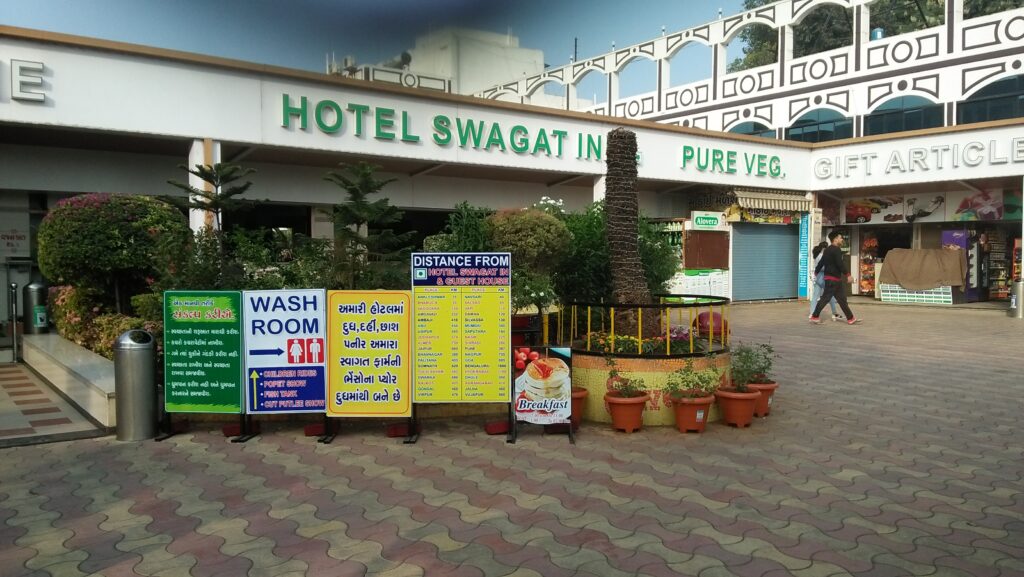
Another dense and foggy morning when we left Udaipur at 4am to join the GQ that would take us to Delhi and then on to NH334 to Haridwar. We drove past Ajmer and Chittorgarh, but my family was fast asleep to notice these historical signposts. We could stop for a meal break only at around 11:30am when we found a hotel run by the National Highway Authorities of India (NHAI) called NH8. Desperately hungry, we ordered a heavy brunch of parathas, chole bature, puri bhaji, lassi, ice-cream… not knowing when the next meal would be had. The washrooms were clean, and the food was served hot and tasted good. We relaxed there for an hour before we headed out again. The Jaipur-Delhi leg was terrible that year as there were road construction and diversions galore and, after losing our way in Delhi (we missed the turning in the outer ring road that avoided the city) we finally reached Haridwar at 10:30pm, 5 hours later. We had driven past Ghaziabad, Meerut, Muzaffarnagar and Rourkee. It was a terribly long day for us, especially so for Amma and Appa, who coped well. We rushed into our hotel rooms, had a warm bath and dinner and crashed for the night.
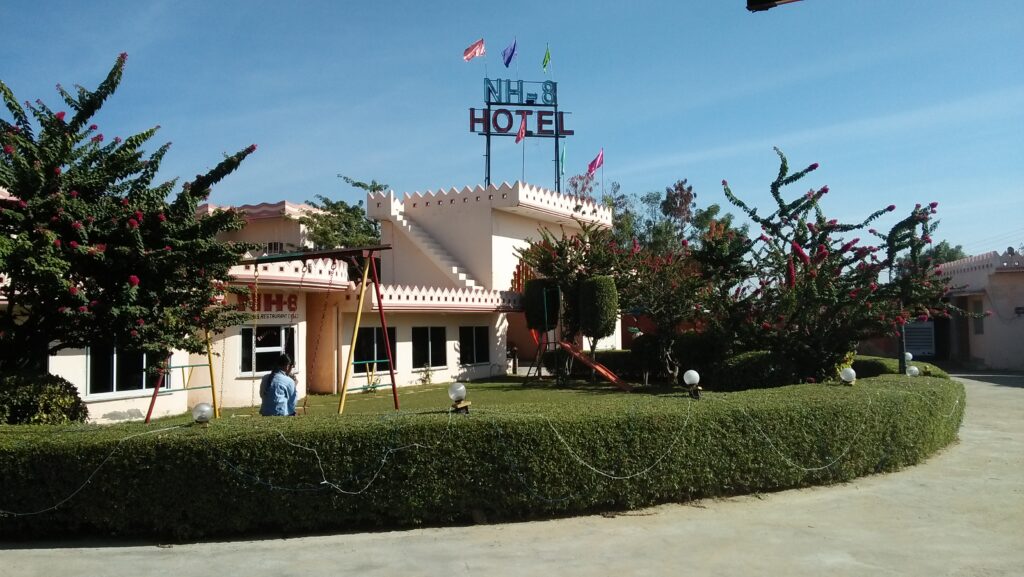
Hotel Alaknanda in Haridwar was right on the banks of the river Ganga! The GMVN (Garhwal Mandal Vikas Nigam) of the Uttarakhand government, has guest houses and bungalows at stunning locations across the state. And Alaknanda in Haridrwar was one of our favourites. High-ceilinged, spacious rooms, ours facing the Ganges, prime location (just a few steps down to the holy river), wonderful food and walking distance from Har-ki-Pauri. What more could we ask for? We spent two relaxing days there till we were all well rested, including our car and driver. Since the weather was chilly, Amma requested the hotel staff to fill buckets from the Ganga for us so we could bathe in her waters in the convenience of our rooms. Had it been less chilly, we would have dunked in.
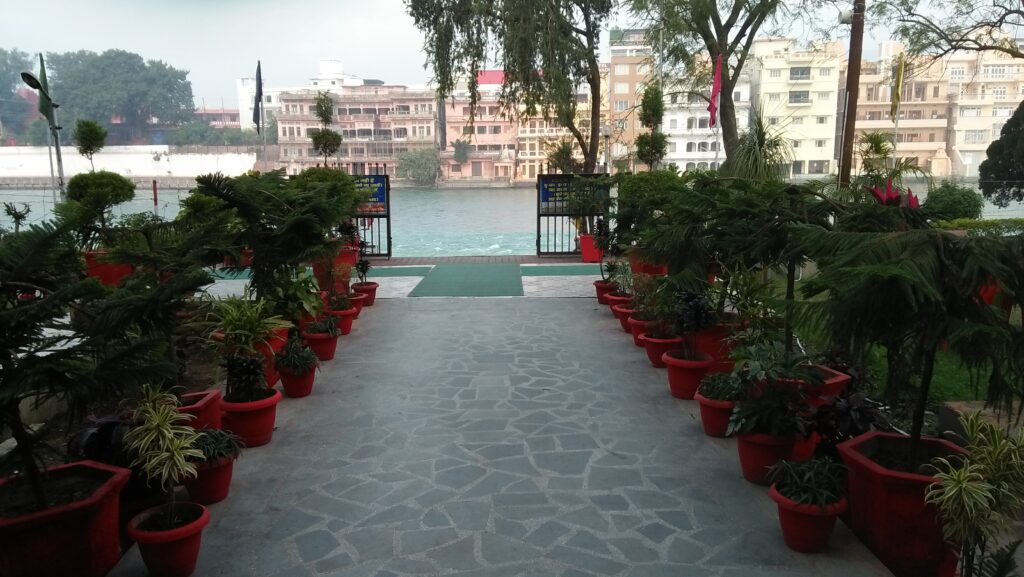
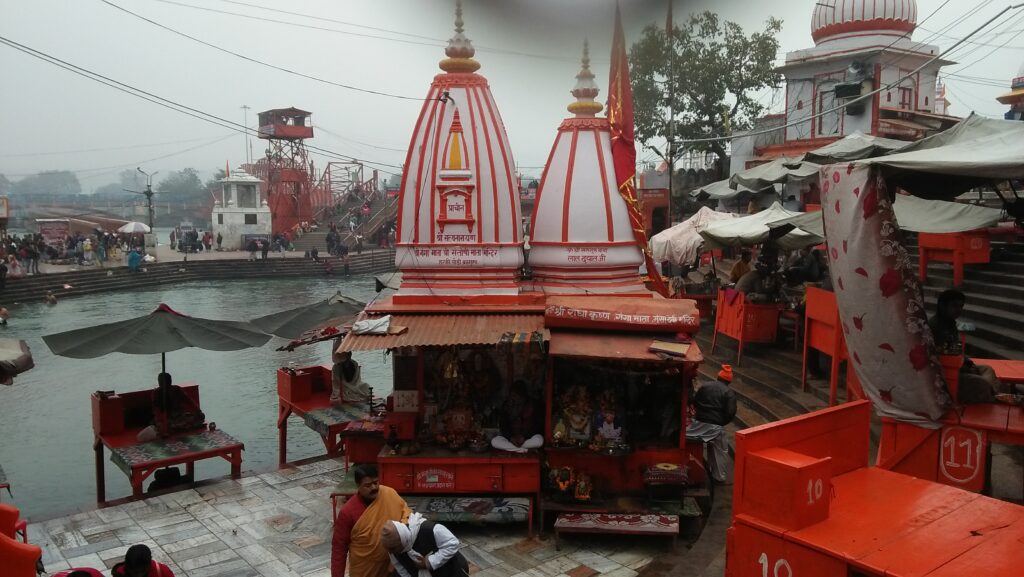
After breakfast the next morning we walked leisurely to Har-ki-Pauri. It was a colourful sight in bright orange and white. After visiting the temples and took a narrow lane near the bridge to get to the starting point of the cable car that took us to the Mansa Devi temple on the nearby hill, Bilwa Parvat. After a good darshan and on our way back to the hotel, we stopped for lunch at the famous “Mathura Walon Ki Pracheen Dukan” for delicious puris, 2 subzis, gajar halwa, lassi and raita. We went back to Har-ki-Pauri in the evening for the Ganga aarti. Amma and my daughter lit small lamps from the huge, brass, aarti lamps and set them floating down the river with wishes and prayers for the family. The river was alive with hundreds of such lamps. It was indeed a beautiful sight. At peace, we walked back to the hotel for dinner and a good night’s rest.
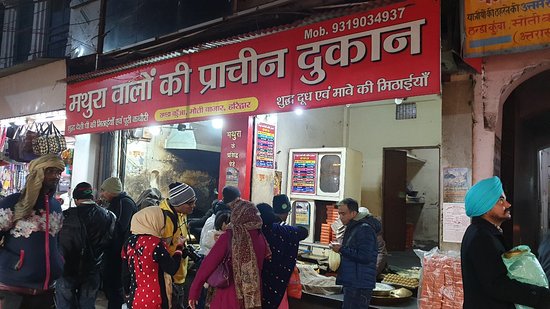
The next morning, the 4th day of our trip, we drove 33 Kms to Rishikesh and walked across the Laxman Jhula to the Trimbakeshwar temple where one moved from floor to floor and room to room to see representations of various deities. The Ganges was a gorgeous sight as she flowed below. Amma had got tired after the long walk and we stopped at a juice centre that served fresh juice, unadulterated by water, sugar and spices. The juices were superb, and we felt refreshed. We rested at the hotel after lunch, gearing up for the next leg of the journey.
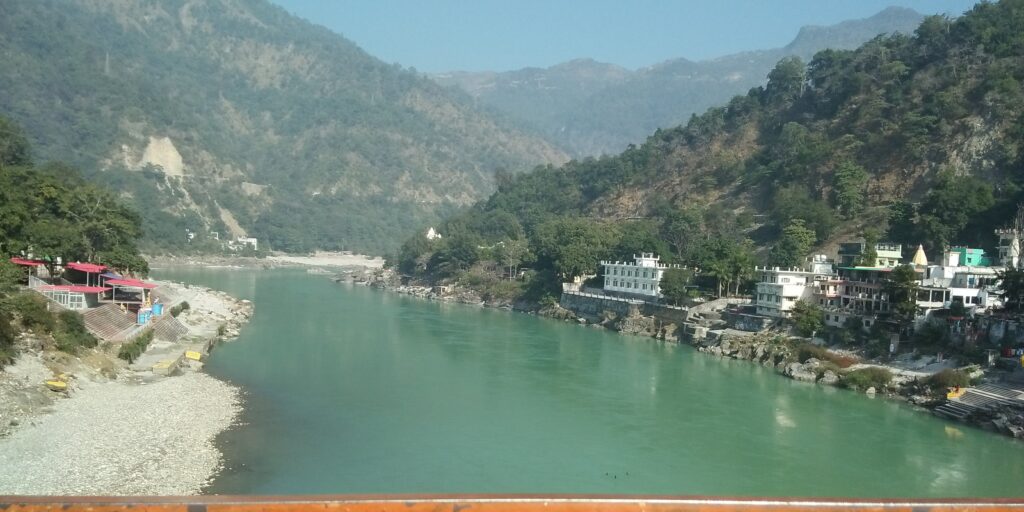
We left for Agra after a heavy breakfast, a 400km drive first on the NH334 followed by NE3 and then on the six-lane Yamuna Expressway. It was a superb drive. The only drawback at that time seemed a shortage of food courts along the route. We saw one only when we neared the exit route to Agra and that too with limited options. We all had ice-cream for lunch at the lone food court. We exited the expressway at Agra and, with multiple signboards guiding us to the monument, found our way to the exquisite, stunningly symmetrical beauty, the Taj Mahal. The sky was still not clear, but nothing, not even the elaborate, ugly and irritating barriers set up in the name of security could mar the beauty of the labour of love. The monument looks even more stunning with each viewing. Our hotel, Taj Resorts, was right outside the entrance to the monument and we occupied two inter-connecting rooms. We had lovely dinner in the roof-top restaurant. It was cold, but they kept a portable heater near our table and the ghazal singer’s soothing voice coupled with excellent food and service served to keep us warm. We would have loved to have seen the Taj Mahal from the rooftop, but the air was dense with fog.
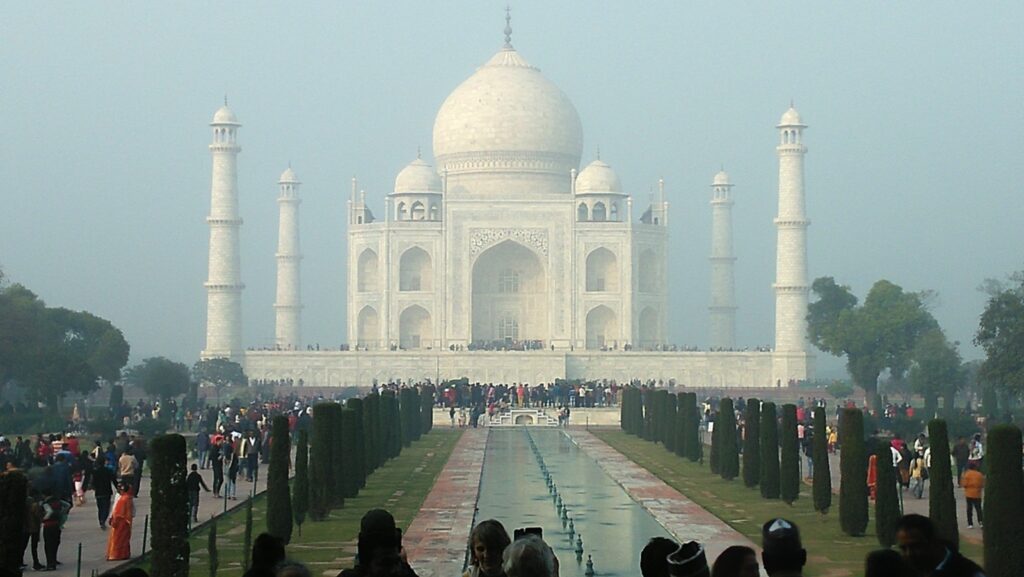
We were scheduled to leave for Lucknow after breakfast but decided to first visit the Agra Fort. It was spectacular! As always, we hired a government certified guide to help take us around the citadel and explain its history and architecture. My daughter loved the palanquin-shaped rooms of Begum Jahanara and Begum Roshnara, Shah Jahan’s daughters. The most poignant of all was the tower where Shah Jahan, imprisoned by his son Aurangzeb within the fort, would stand and stare at the mausoleum of his beloved wife Mumtaz.
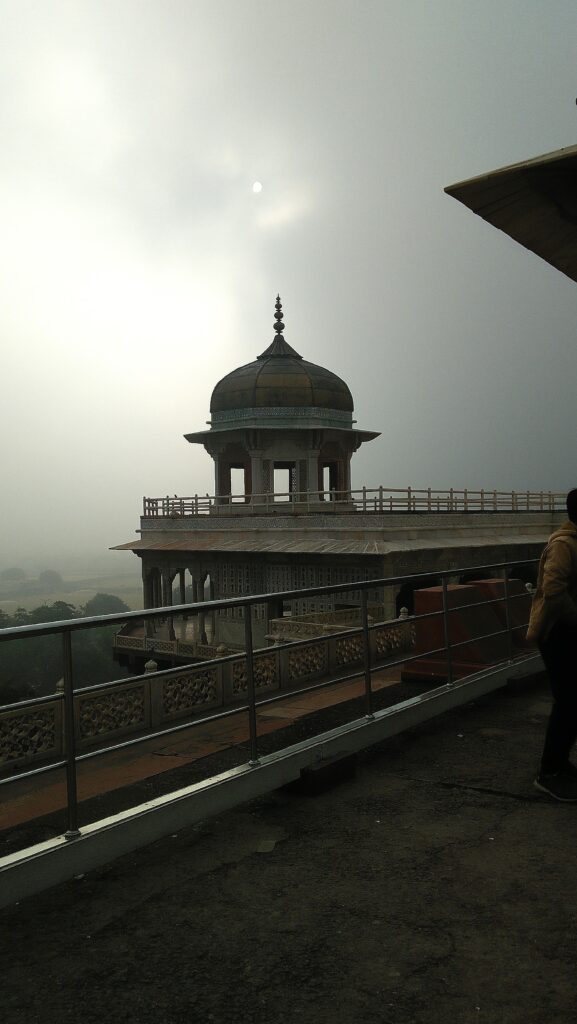
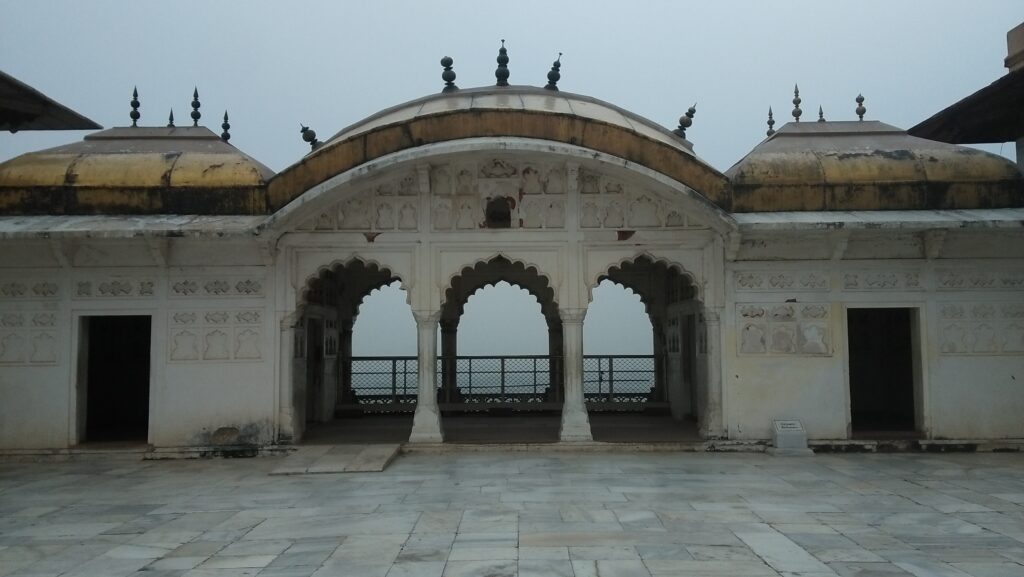
We took the Agra – Lucknow expressway and entered Lucknow 4 hours later crossing the beautiful Gomti river. Curfew was imposed on the state capital as Article 370, granting special status to J&K, had been recently revoked by the central government. Internet communication within the state was suspended and all places of interest for tourists were closed shut. Only very few shops remained open. So we stayed within the parameters of our hotel La Place Sarovar Portico, where we had inter-connecting rooms. It was a beautiful hotel with superb restaurants. We did venture out in the evening and to our delight found one clothes outlet open with the famous Lucknow Chikan work. We did all our shopping for the family there. We also stopped at roadside stalls to savour the famous Lucknow chaat.
The next morning, day 7 of our trip, we left for Ayodhya after a light breakfast to see the much-in-the-news Ram Janmabhoomi, believed to be the birthplace of Sri Ram and his brothers, on the banks of the river Sarayu. It was a 2 1/2-hour journey covering 135kms via NH27, heavy fog throughout. Nearer to Ayodhya, we got off the main highway and entered a little culvert, took a U-turn and climbed onto a mud road that turned right and lead into the city. There were police personnel everywhere. As soon as the car climbed up to the road, some of them came and pleasantly looked us over, seated inside. Amma always wore large red pottu on her forehead (powder, not sticker). She also had on one of her Kanjeevaram silk sarees. One look at her and they nodded for us to go ahead. There were crowds everywhere, but all moving gently. We were looking to park the car and suddenly, from nowhere a person approached us and promised parking space ahead. One thing lead to another and, gullible as always, we fell for the old trick and ended up losing rs.1000 to some fake sadhu who ‘blessed’ us and pocketed the ‘donation’.
We entered the large, open complex where the temple for Lord Ram was to be built after the courts resolved the ongoing land dispute. We were astonished! There were rows and rows of bricks of all colours and sizes brought from all over the world by devotees as contribution to the building of the temple. Each brick had the words श्री राम written on it. People standing in queue at the entrance all carried a brick each to be added to the thousands piled inside. We were truly humbled by the devotion of all.
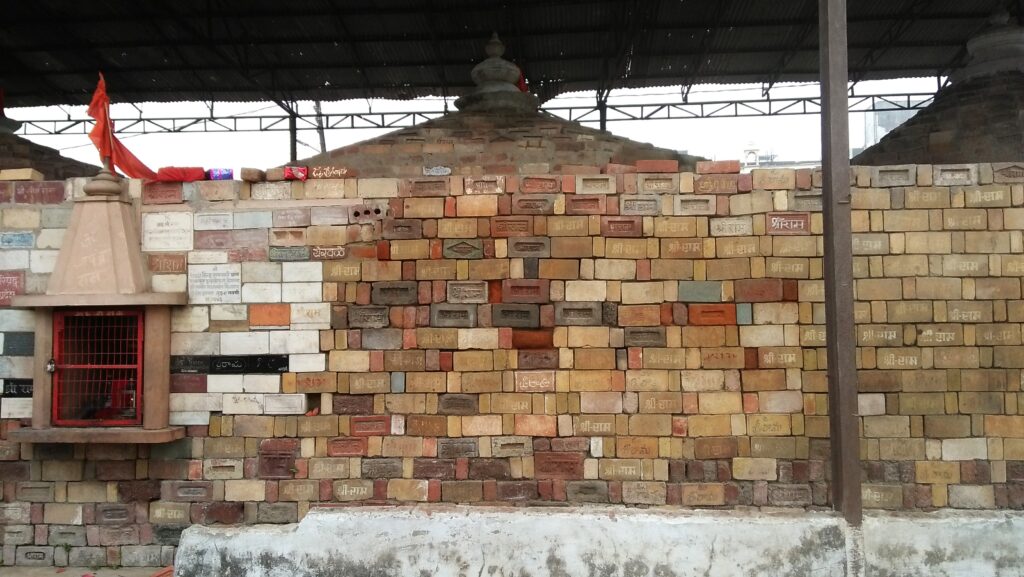
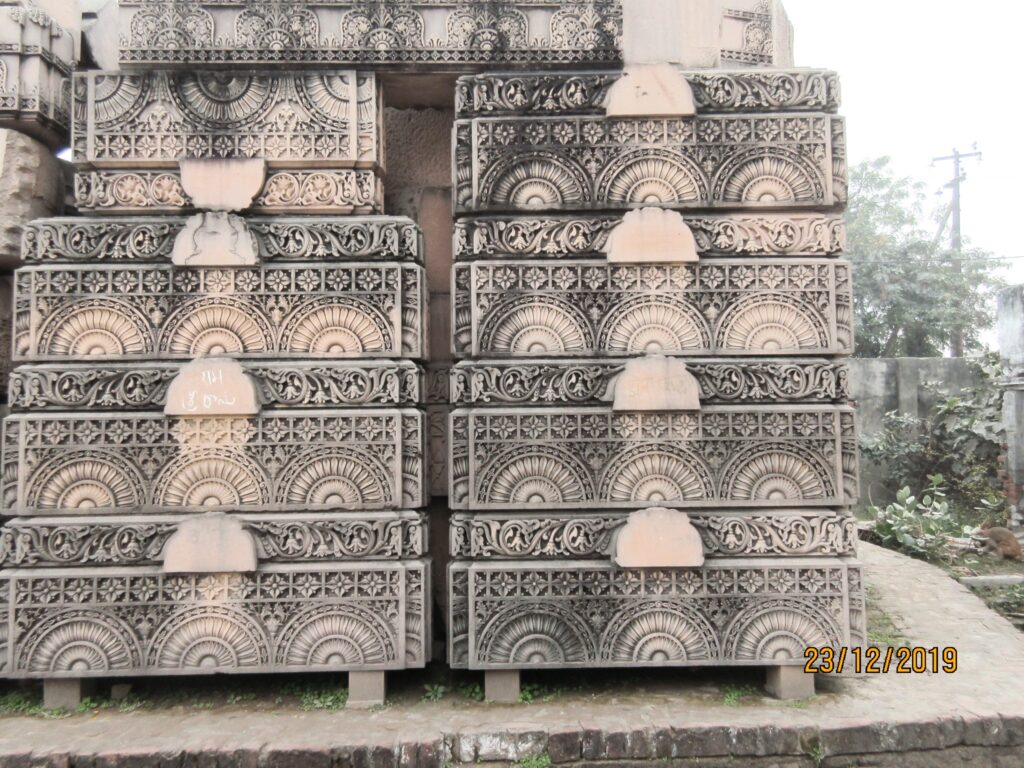
Since the janmbhoomi site was closed for lunch, we decided to visit the Hanuman temple nearby. My parents and daughter went up the stairs to the temple first and I stayed back to take care of our footwear and bags. I climbed up after their return and saw the aarti being performed for the huge statue of Hanuman. There were pehelwans or wrestlers sitting close to the shrine, ardent devotees all.
We then stood in a queue more than a kilometre in length amid tight security to see the statue of Ram at his place of birth. We did not know what to expect. As we neared the spot, we saw a pandit seated with a thali. As we came close to him walking Indian file, he pointed towards four tiny statues placed on a platform at a distance. Ram Lalla was in the middle surrounded by his three brothers, Laxman, Bharat and Shatrugan. We all bowed in reverence. Amma and Appa felt truly blessed to have seen this sight.
It was around 3pm and we had not yet had lunch. We decided to drive back to Lucknow. We had fantastic tokri chaat from a snack joint near our hotel.
On the morning of 24th December, we had an early breakfast and left for Varanasi; also known as Benaras and Kashi, the holiest place for Hindus. It is said one must visit Kashi once during a lifetime and Amma was keen to go there. We took the NH30 via Rae Bareli and stopped at Allahabad to see the Triveni Sangam of the Ganga, Yamuna and the mythical Saraswati rivers. Allahabad (Prayagraj) was bustling with activity in preparation for the Kumbh Mela in early 2020. There were huge tents being erected and hundreds of security personnel and administrators organizing orderly movement of infrastructure and personnel. We went to the edge of the river bank which was slushy with wet mud. Amma requested a local standing nearby to get us some river water in a mug. She then sprinkled it on all of us and herself. We didn’t have time for a boat ride and we left immediately for Kashi. We had lunch in a mall enroute and reached our destination hotel Temple on the Ganges on Assi Ghat at around 7:30pm, after driving through the campus of the renowned BHU (Benaras Hindu University) and crowded narrow lanes. Stationing Amma and Appa in their room, my daughter and I went out and tried some superb street food (tamatar chaat, samosas, rabdi, dahi wada) and bought some for them too. After dinner we stood in our balcony facing the river and saw all the beautifully lit Ghats to our left.
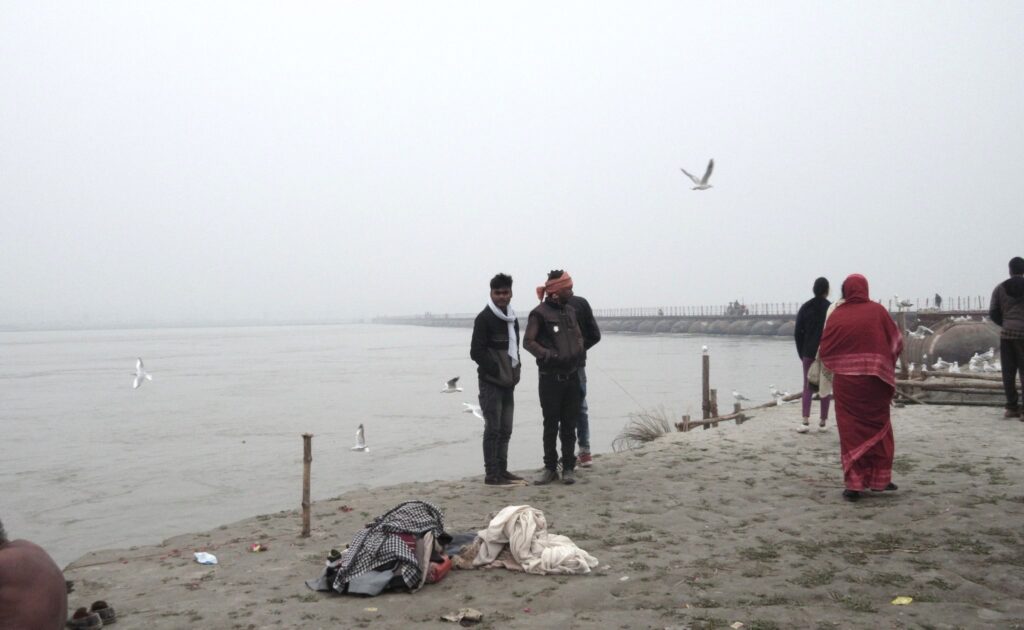
The next morning, we rose early and after a cup of coffee, we joined a pandit on Assi Ghat where Appa and Amma performed a pooja for our ancestors. Amma was dressed traditionally in a 9 yards saree and Appa in a shirt and veshti. We were shivering with cold. After the rituals were completed, we took a boat and once in the middle of the river, Appa released the pooja materials into the Ganga with prayers. We stopped at Kedar Ghat and holding their hand tightly, climbed the steep, high steps to the temple on top. We waited within for the arati to be completed, came back to the boat and finally walked back to our hotel. It was 10:30am and we were hungry, surviving on coffee the whole time. We stopped at a nice restaurant named Madhuban for breakfast and proceeded from there to Sarnath, 10kms from our hotel.
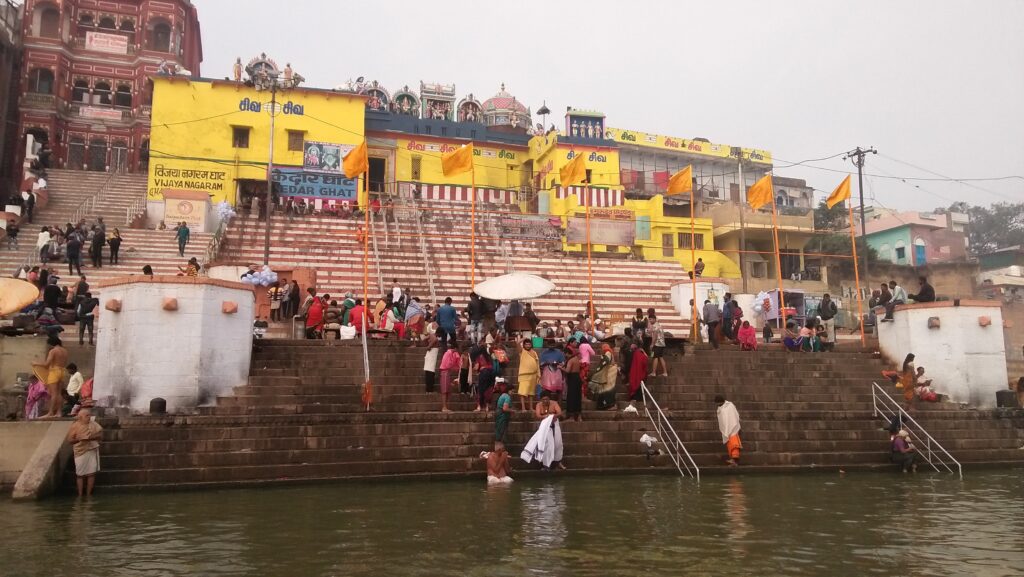
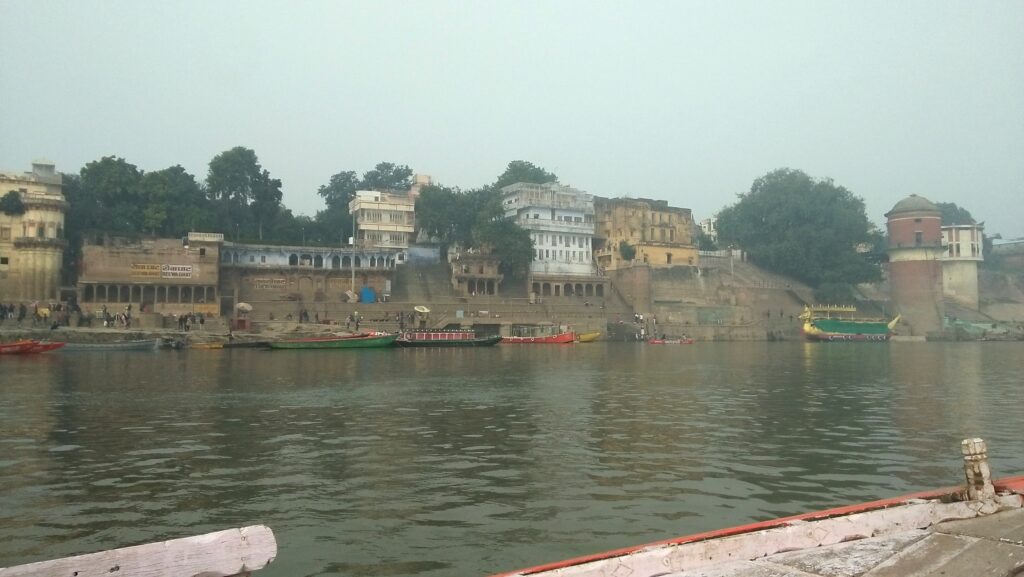
Sarnath, where Gautama Buddha taught his first sermon after attaining enlightenment! We entered the vast area strewn with broken structures, mute testament to the plunders and destructions by Islamic invasions. The Dhamekh Stupa, the precise location where Buddha preached to his first 5 disciples still stood intact. The original pillar of Ashoka the Great was broken and its parts were enclosed in glass for visitors to view. Many countries following Buddhism had established their temples and monasteries in Sarnath. We visited the Sarnath Archeological Museum and were stunned to see the original Lion Capital of Ashoka, which then became the national emblem of India. We also saw the Ashoka Chakra, though broken in pieces. Stunning sculptures of that era were part of the exhibition. It was an educational experience for us all, our history textbooks coming alive in front of us. Amazed and grateful, we departed back to Benaras.
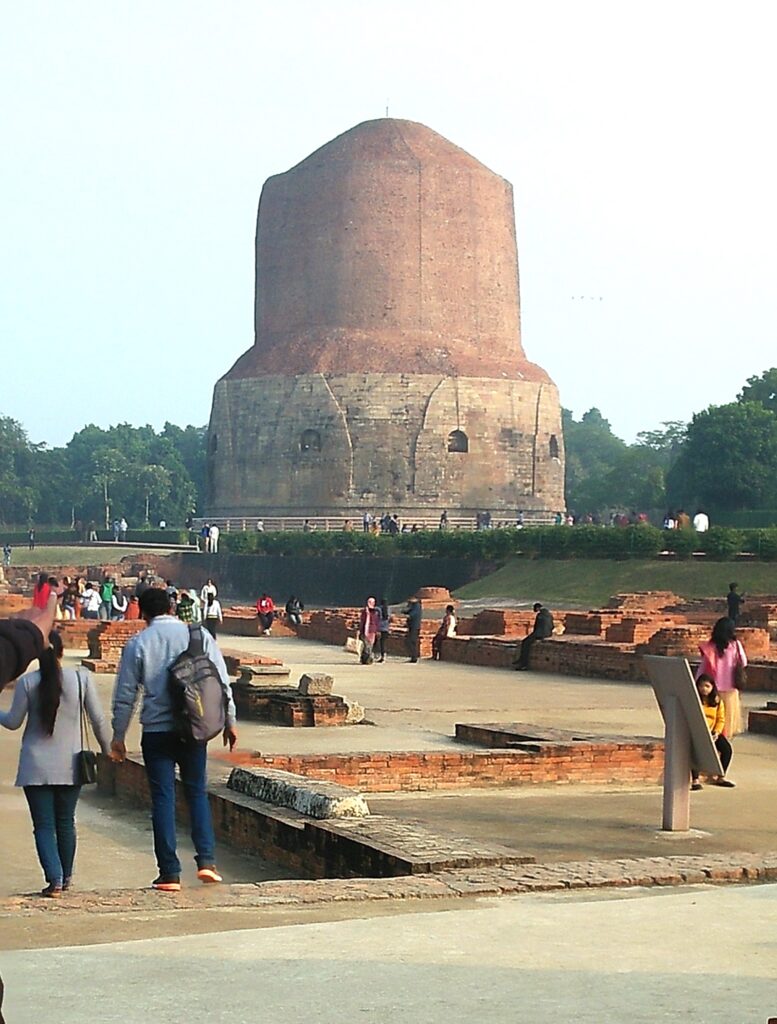
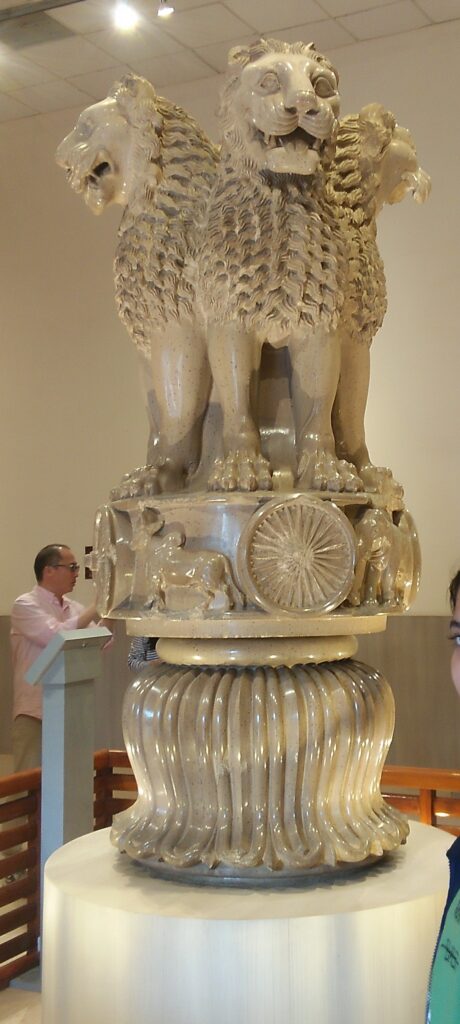
The magic did not stop there. We stopped near the crowded Dasashwamedh Ghat and walked to join the queue to visit the great Kashi Vishwanath temple. Security was strict and after depositing our footwear, mobile phones and cameras at a shop, we waited our turn patiently along with a thousand others to get a glimpse of the great Lord. Amma bought a basket with flowers and milk. We neared the sanctum where the Shivalinga was covered with garlands and surrounding priests chanted slokas in unison. Amma poured the milk on the linga. I was completely focused on my thoughts, when suddenly, I felt a garland being flung round my neck by a priest. Stunned, I walked slowly away when I saw that Appa had also been garlanded. Maybe this was common practice, but it was all new to us, and we felt special that day! We went to the Annapurni Devi temple next and Amma and my daughter received the priest’s blessings. Feeling light after a long day, we picked up our belongings, shopped for colourful bangles for my daughter and went back to our hotel. Wonderful day indeed!!
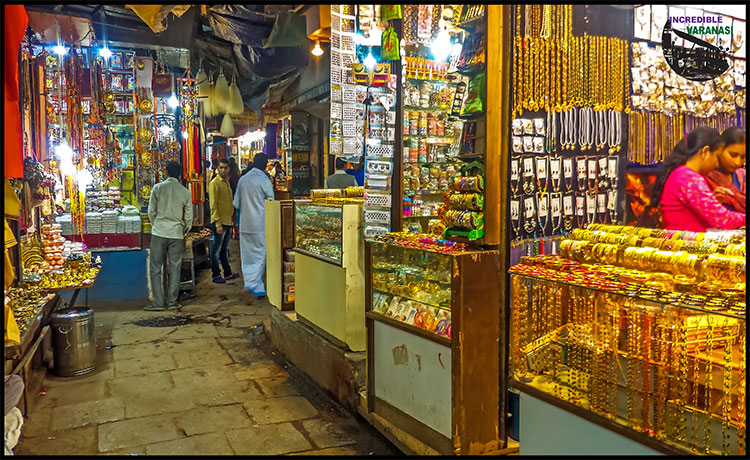
Our 10th day on the road and we left early morning at 4am to Bodh Gaya, 256 kms and 5 ½ hours away via NH19. Once again, it was foggy and we could barely see a metre ahead. The skies cleared after 3 hours. We reached Bodh Gaya at around 9am and headed to a funky restaurant, Nirvana, for breakfast. In the washroom, Appa received a slight cut on his forehead. We rushed him to a doctor and got his wound treated. Bodh Gaya was very well administered. A large open area housed a number of tents that had doctors and other service personnel ready to help tourists in need. We thanked the good doctor and went to the Mahabodhi temple that housed the Bodhi tree where Gautama Buddha had attained enlightenment. A local offered to show us around. What struck us was the extreme peace and quiet in the whole premises, though there was a large crowd. There was an aura of gentleness that pervaded the whole place. A number of maroon-robed monks circumambulated the temple with turns of their bodies. Others meditated in silence. It was all wonderful to behold. We left reluctantly for the 5-hour drive back to our hotel in Varanasi.
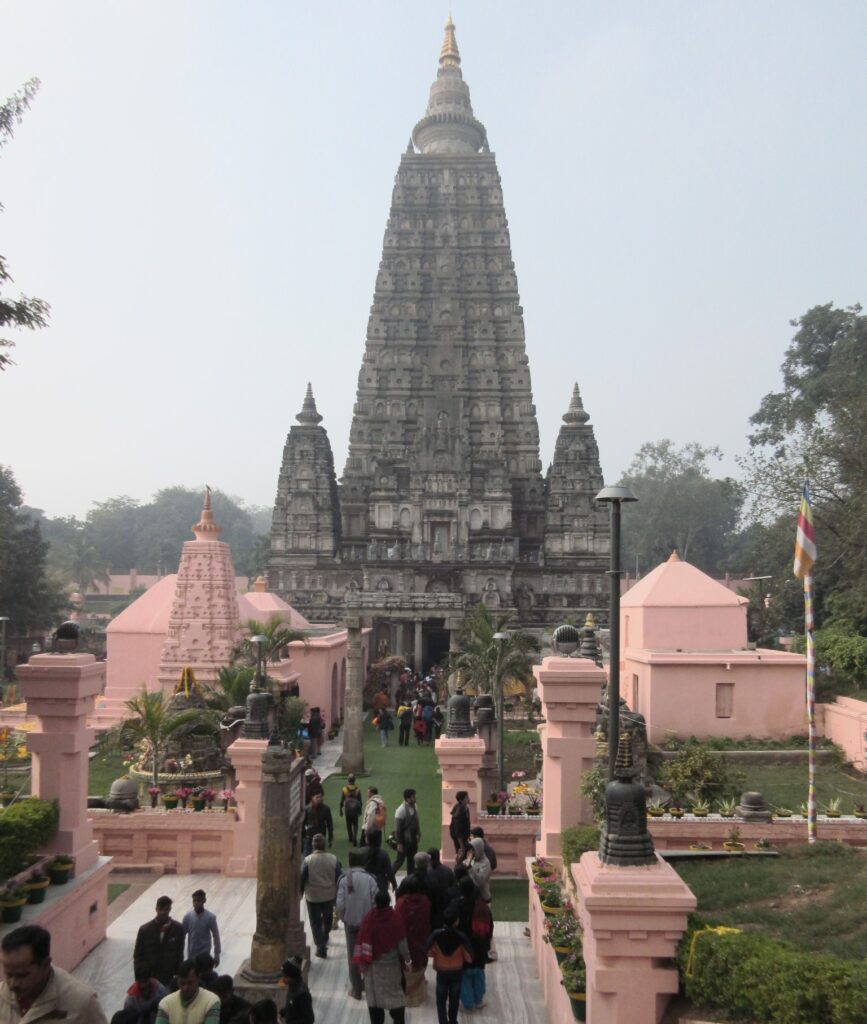
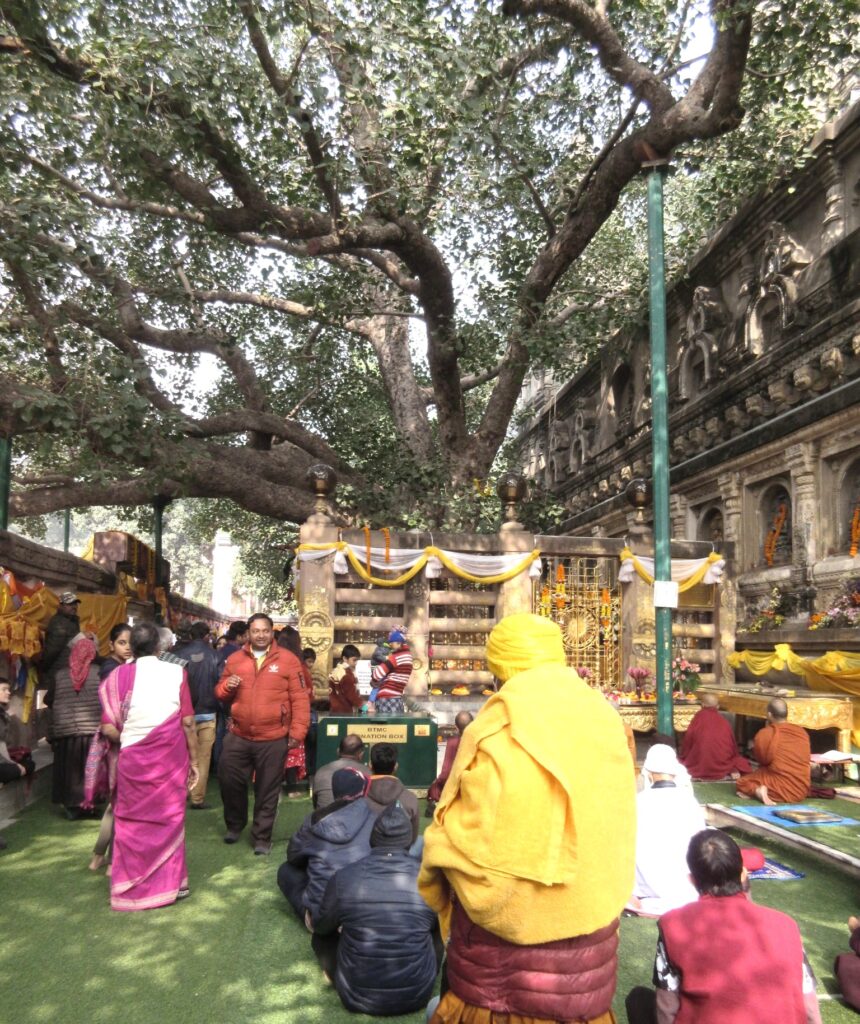
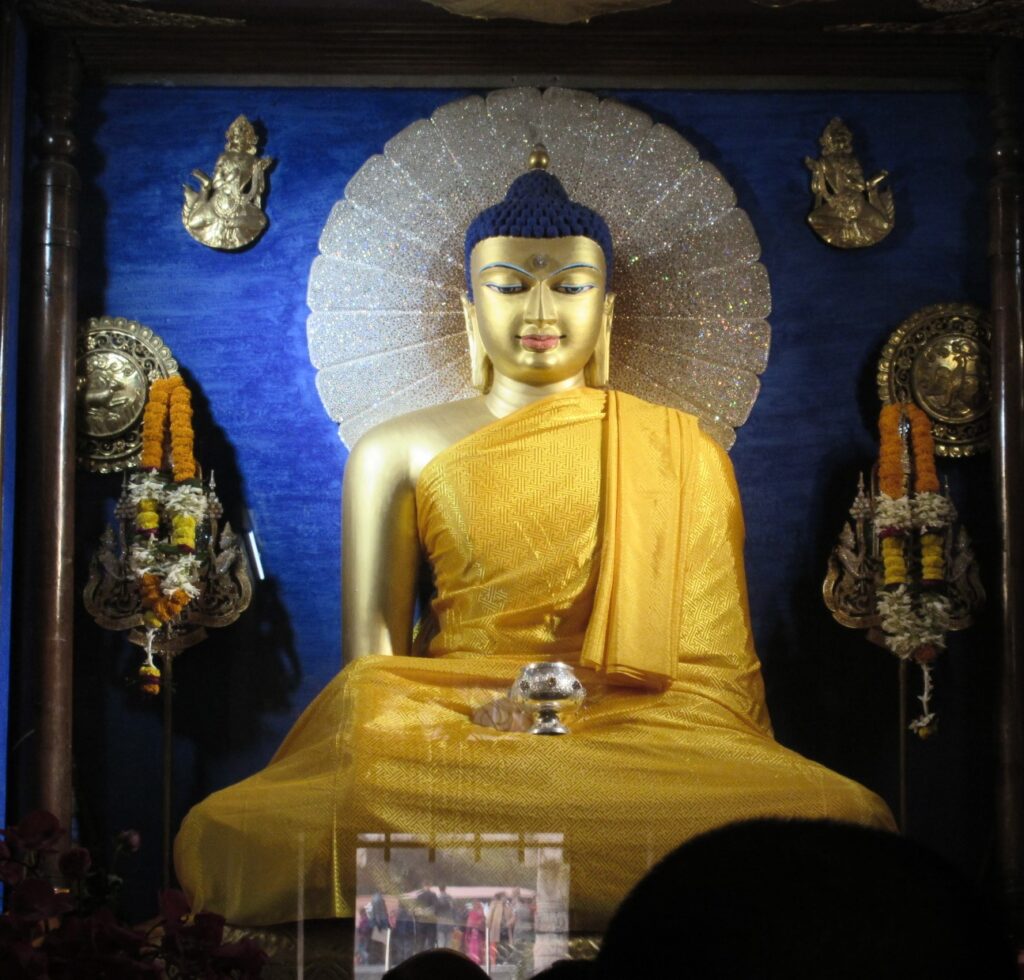
We left Varanasi, and UP, the next morning and drove 390 Kms to Khajuraho in Madhya Pradesh passing Mirzapur, Rewa and Satna and Panna Tiger sanctuary via NH 135, NH30 and NH39. We were on the road for 10 hrs. A patchy road with sharp stones caused our Altis to get a flat tyre. Our driver replaced it with the stepney tyre. Fortunately, we found a tyre shack close by and we got the punctured tyre repaired. This was the one and only time our beloved car was troubled. We reached our place of stay Hotel Isabel Palace late in the evening. After breakfast the next morning, we went along with an expert guide (recommended by the hotel) to the magnificent Khajuraho temples.
Built by the Chandela Kings in a span of 100 years, the fabulous temples were artistic wonders. We had a very knowledgeable guide who explained the history and the architecture of the temples, the subtle gestures of the sculptures in stone. Gods and Goddesses and common folk living their daily lives and loves were captured with great dexterity and finesse.. My daughter climbed up to the massive statue of Nandi the Bull, which faced the great Kandariya Mahadeva temple, and whispered something into his ear. She said he would make her wish come true. We visited the Eastern group of temples too. Appa held long discussions with our guide who was extremely patient. Both the grandparents coped wonderfully well during the whole visit. We came back to the hotel for a late lunch, stunned and enthralled by what we had seen. Such marvels we had never imagined existed.
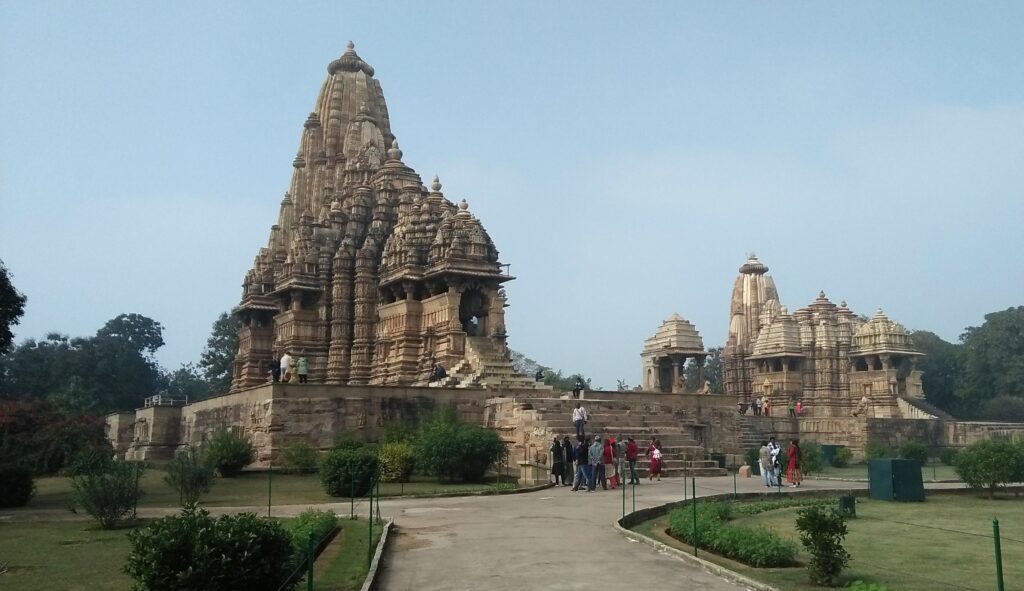
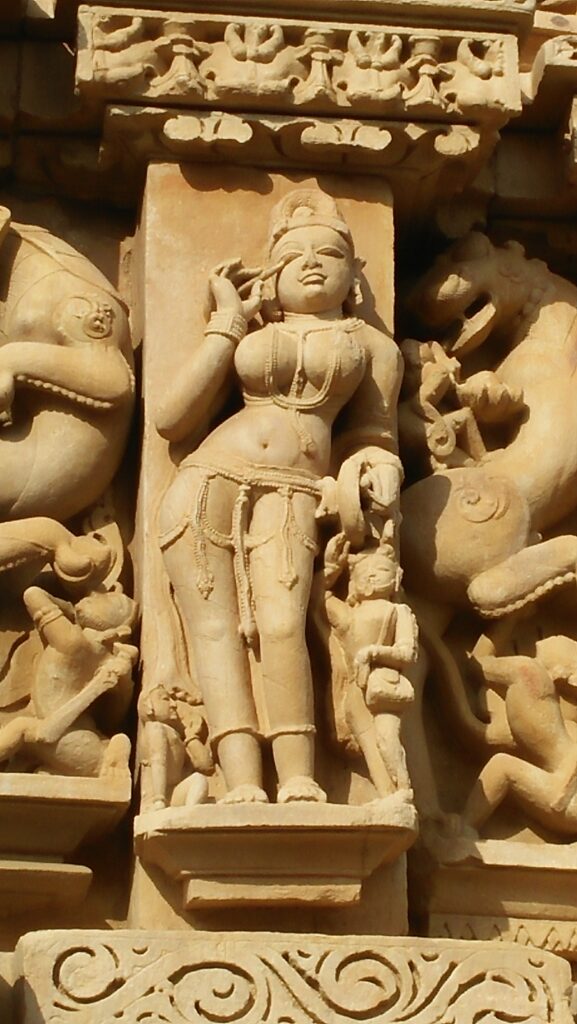
And so, the penultimate day of our long and enlightening trip. We drove the 565 Kms from Khajuraho to beautiful, clean, Indore and to our hotel Lemon Tree on day 13. A lovely hotel with a fantastic restaurant. We visited the famous Khau Gulley in the evening and tried some of the fare on offer. We also purchased some of the famous snacks for family and friends. After a restful night, we did the final leg to our home in Mumbai, deeply grateful for all that we had seen and experienced. As always, Appa went to the temple and broke a coconut as an offering of thanks to Ganesha.
Leave a Reply